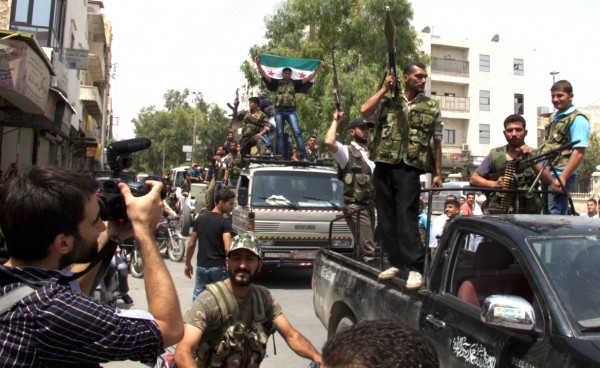Guest post by Miguel Toran:
With the killing in mid-July of Bashar al-Assad’s top security aides, the Syrian revolution gained momentum. Syria had been sealed off for months so international media flocked to Turkey and Lebanon predicting the collapse of the regime and a sudden opening of its borders.

I was deployed to the Turkish-Syrian border to join a small Al Jazeera team to get inside as soon as possible. We were supposed to be smuggled across the border on foot so we had to travel light and take as little equipment as possible. Clothing, camera equipment, MRE rations, communication devices and a first aid kit had to fit in a backpack light enough to be carried in case of long distance walks. Moreover there was the danger of running into the government forces’ checkpoints, so a camera that could be concealed under a shirt was a must, too.
My camera of choice for this kind of assignment – the Sony EX1 – was not an option this time. So I turned to the 5D mkIII I had just bought a few weeks earlier. Al Jazeera cameraman Ben Foley, who had been inside Syria previously, helped advise me on what and what not to take.
In the end, this was my shooting kit:
5D mkIII
Zacuto Z-Finder
Canon 16-35mm f2.8
Canon 24-70mm f2.8
Rode VideoMic Pro
Variable ND filters
Tascam DR-40 audio recorder
Sennheiser ME66
Litepanel Micro
Sennheiser EW100 ENG G3
Panasonic TM700 as spare camera
Sony A1 camcorder as a second spare camera and for possible live-crosses.
No tripod or monopod. I would have preferred to take the 24-105mm instead of the 24-70mm but I didn’t have it with me. And the 70-200 was way too heavy to take, so I used the Panasonic TM700 camcorder when I needed any zoom. It has an amazing image stabiliser!
And what about the 5D mkIII? We all know it is a great camera, with stunning HD and nice depth of field and is amazing in low light. I had loads of fun shooting with it in Syria. But let’s be fair, it is not the perfect camera to take to this kind of environment when you are doing news. Most of the problems we all have with these cameras get multiplied when shooting in a hostile area.
Reason 1: Where is my iris ring?
It was very sunny and all the time we were going from bright areas to shade, from small cars to the trunk of a pickup, from open streets into pitch-black apartments… Dialling a new exposure in an ND filter is not as smooth as doing it through the lens iris ring on the broadcast cameras. Most of the time I would get one of my fingers in front of the lens, ruining the shot… On top of that, to screw the filter on and off every time you get into a house is a headache.
Reason 2: I miss you, audio channel 2.
The Rode VideoMic Pro was on the camera all the time. But if something happened and the reporter wanted to do a piece to camera or an interview I was supposed to plug the Sennheiser wireless in to get proper voice track. Unfortunately, there was usually no time to start changing mics. So we had to record the reporter’s audio in the Tascam she was carrying and later sync it. By the way, the VideoMic Pro breaks down so easily… mine broke the first day of the assignment. God bless gaffer tape.
Reason 3: Transcoding, 1%.
Prior to July it was very difficult to send the packages from inside the country because government forces could pinpoint your satphone location and shell it, as it seems happened to Marie Colvin. So you had to take all your footage back to Turkey and edit and feed from there. This time the area north of Aleppo was quite safe and we could cut and send inside the country. But before editing we had to transcode 40 to 80gb of daily footage. Slow. Very slow, even using the 5DtoRGB software. The problem was not the amount of time it could take; the problem was the constant power cuts. Sometimes we had only 6 or 8 hours of electricity per day: not enough to transcode, sync the audio, edit, compress and feed.
This is why I think for this assignment small broadcast cameras like the Sony NX-70, the Canon XF 105 or the JVC HM-150 would have done a better job. Maybe you don’t get the depth of field and you will miss the super wide angle of the 16-35, but at least you are assured almost 100% of the shots recorded will be usable. So… maybe the answer is to turn to the C300 or the C100. A good mix between a HDDSLR and a broadcast camera? Are they suitable for this kind of assignments? I would like to try next time.
Miguel Toran is a freelance cameraman for the Al Jazeera English network. You can see more of his work on his website.






